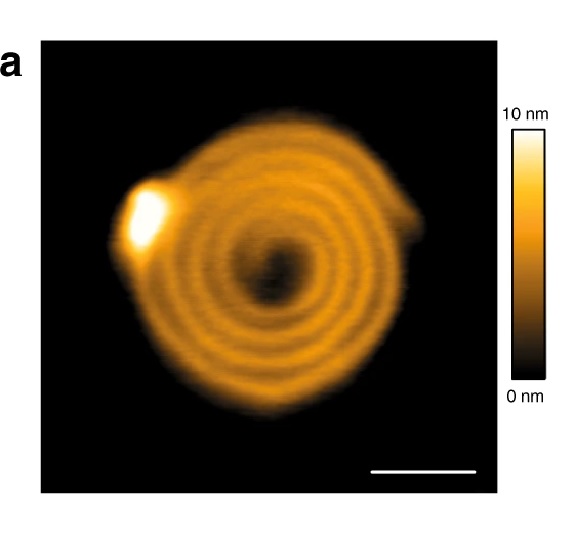
Happy Birthday Switzerland


In the article “Determination of polarization states in (K,Na)NbO3lead-free piezoelectric crystal” Mao-Hua Zhang, Chengpeng Hu, Zhen Zhou, Hao Tian, Hao-Cheng Thong, Yi Xuan Liu, Xing-Yu Xu, Xiao-Qing Xi, Jing-Feng Li and Ke Wang describe how polarization switching in lead-free (K0.40Na0.60)NbO3 (KNN) single crystals was studied by switching spectroscopy piezoresponse force microscopy (SS-PFM).*
Acquisition of multiple hysteresis loops on a closely spaced square grid enables polarization switching parameters to be mapped in real space. Piezoresponse amplitude and phase hysteresis loops show collective symmetric/asymmetric characteristics, affording information regarding the switching behavior of different domains. As such, the out-of-plane polarization states of the domains, including amplitudes and phases can be determined.*
The results presented by the authors could contribute to a further understanding of the relationships between polarization switching and polarization vectors at the nanoscale, and provide a feasible method to correlate the polarization hysteresis loops in a domain under an electric field with the polarization vector states.*
PFM and SS-PFM were implemented on a commercial Atomic Force Microscope using NanoWorld PlatinumIridium coated Pointprobe® EFM AFM probes.
![Fig. 1 from “Determination of polarization states in (K,Na)NbO3lead-free piezoelectric crystal” by Mao-Hua Zhang et al: PFM imaging and a schematic of tip movement during SS-PFM mapping. (a) Piezoresponse amplitude and (b) phase contrast images of the KNN single crystals. (c) In SS-PFM, local hysteresis loops are collected using a waveform at each pointon 25 × 25 mesh. The domain wall shown in Fig. 1(b) orients along [001]c.](https://dhipgo7nn2tea.cloudfront.net/wp-content/uploads/2020/07/25112255/figure-1-from-Mao-Hua-Zhang-et-al-2020-Determination-of-polarization-states-in-KNaNbO3lead-free-piezoelectric-crystal-NanoWorld-Pointprobe-EFM-AFM-probe-1-1-1024x536.jpg)
*Mao-Hua Zhang, Chengpeng Hu, Zhen Zhou, Hao Tian, Hao-Cheng Thong, Yi Xuan Liu, Xing-Yu Xu, Xiao-Qing Xi, Jing-Feng Li, Ke Wang
Determination of polarization states in (K,Na)NbO3lead-free piezoelectric crystal
Journal of Advanced Ceramics2020, 9(2): 204–209
DOI: https://doi.org/10.1007/s40145-020-0360-2
Please follow this external link to read the full article: https://link.springer.com/content/pdf/10.1007/s40145-020-0360-2.pdf
Open Access The article “Determination of polarization states in (K,Na)NbO3lead-free piezoelectric crystal” Mao-Hua Zhang, Chengpeng Hu, Zhen Zhou, Hao Tian, Hao-Cheng Thong, Yi Xuan Liu, Xing-Yu Xu, Xiao-Qing Xi, Jing-Feng Li and Ke Wang is licensed under a Creative Commons Attribution 4.0 International License, which permits use, sharing, adaptation, distribution and reproduction in any medium or format, as long as you give appropriate credit to the original author(s) and the source, provide a link to the Creative Commons license, and indicate if changes were made. The images or other third party material in this article are included in the article’s Creative Commons license, unless indicated otherwise in a credit line to the material. If material is not included in the article’s Creative Commons license and your intended use is not permitted by statutory regulation or exceeds the permitted use, you will need to obtain permission directly from the copyright holder. To view a copy of this license, visit http://creativecommons.org/licenses/by/4.0/.
The Endosomal Sorting Complex Required for Transport-III (ESCRT-III) is part of a conserved membrane remodeling machine. ESCRT-III employs polymer formation to catalyze inside-out membrane fission processes in a large variety of cellular processes, including budding of endosomal vesicles and enveloped viruses, cytokinesis, nuclear envelope reformation, plasma membrane repair, exosome formation, neuron pruning, dendritic spine maintenance, and preperoxisomal vesicle biogenesis.*
How membrane shape influences ESCRT-III polymerization and how ESCRT-III shapes membranes is yet unclear.*
In the article “Human ESCRT-III polymers assemble on positively curved membranes and induce helical membrane tube formation” Aurélie Bertin, Nicola de Franceschi, Eugenio de la Mora, Sourav Maity, Maryam Alqabandi, Nolwen Miguet, Aurélie di Cicco, Wouter H. Roos, Stéphanie Mangenot, Winfried Weissenhorn and Patricia Bassereau describe how human core ESCRT-III proteins, CHMP4B, CHMP2A, CHMP2B and CHMP3 are used to address this issue in vitro by combining membrane nanotube pulling experiments, cryo-electron tomography and Atomic Force Microscopy.*
The authors show that CHMP4B filaments preferentially bind to flat membranes or to tubes with positive mean curvature.*
The results presented in the article cited above underline the versatile membrane remodeling activity of ESCRT-III that may be a general feature required for cellular membrane remodeling processes.*
The authors provide novel insight on how mechanics and geometry of the membrane and of ESCRT-III assemblies can generate forces to shape a membrane neck.*
NanoWorld Ultra-Short AFM Cantilevers USC-F1.2-k0.15 were used for the High-speed Atomic Force Microscopy ( HS-AFM ) experiments presented in this article.*

*Aurélie Bertin, Nicola de Franceschi, Eugenio de la Mora, Sourav Maity, Maryam Alqabandi, Nolwen Miguet, Aurélie di Cicco, Wouter H. Roos, Stéphanie Mangenot, Winfried Weissenhorn and Patricia Bassereau
Human ESCRT-III polymers assemble on positively curved membranes and induce helical membrane tube formation
Nature Communications volume 11, Article number: 2663 (2020)
DOI: https://doi.org/10.1038/s41467-020-16368-5
Please follow this external link to read the full article: https://rdcu.be/b5rOe
Open Access The article “ Human ESCRT-III polymers assemble on positively curved membranes and induce helical membrane tube formation “ by Aurélie Bertin, Nicola de Franceschi, Eugenio de la Mora, Sourav Maity, Maryam Alqabandi, Nolwen Miguet, Aurélie di Cicco, Wouter H. Roos, Stéphanie Mangenot, Winfried Weissenhorn and Patricia Bassereau is licensed under a Creative Commons Attribution 4.0 International License, which permits use, sharing, adaptation, distribution and reproduction in any medium or format, as long as you give appropriate credit to the original author(s) and the source, provide a link to the Creative Commons license, and indicate if changes were made. The images or other third party material in this article are included in the article’s Creative Commons license, unless indicated otherwise in a credit line to the material. If material is not included in the article’s Creative Commons license and your intended use is not permitted by statutory regulation or exceeds the permitted use, you will need to obtain permission directly from the copyright holder. To view a copy of this license, visit http://creativecommons.org/licenses/by/4.0/.